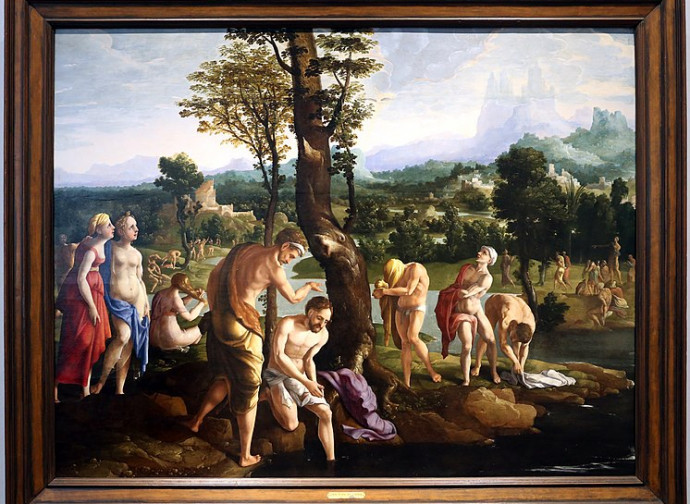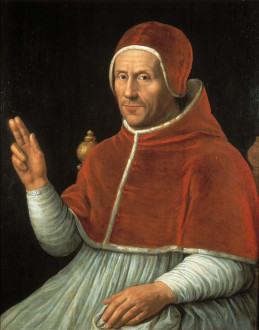The Baptism of Jesus according to van Scorel
Called to Rome by his compatriot Pope Adrian VI, the Dutchman Jan van Scorel is known, among other things, for the Lokhorst Triptych. Also of interest is his The Baptism of Christ in the Jordan, in which the influence of artists such as Michelangelo and Raphael is evident.

During the Renaissance period, the Church had a Dutch pope: Adrian VI (1459-1523), who is also happens to be the last non-Italian pope before the election of John Paul II. Born Adrian Florensz in Utrecht, after intense studies with the Brethren of the Common Life, he became a notable theologian and rector of the University of Leuven. Until 1515 he was tutor to Prince Charles (later to become Charles V), who was very fond of him. It was thanks to the emperor's protection that Adrian Florensz began an extraordinary ecclesiastical rise: first elected bishop of Tortosa, he then became inquisitor of Aragon and Navarre in 1516 and cardinal in 1517. In 1520 he was appointed governor general of Spain. On 9 January 1522, on the death of Leo X, he was elected to the papal throne.
He was the architect of the agreement between the Catholic powers against the Turkish danger (Rhodes fell on 25 December 1522) and took part in the anti-French league led by Charles V (on 3 August 1523) against Francis I, who did not disdain the Muslim alliance. Although wrongly considered disinterested in the arts (and therefore 'barbarian'), Adrian realised that painting and sculpture were important assets for the Church. Thus he decided to appoint a conservator of the Belvedere collection (a position previously occupied by Raphael). The choice fell on one of his compatriots, Jan van Scorel, who was an excellent artist and a man of great faith, who was perfect for the task: in fact, the pope appointed him 'court painter'. The artist also painted a portrait of Pope Adrian VI (see photo) which is in the Centraal Museum in Utrecht.
 It was a very good choice. Van Scorel (1495-1562) was steeped in 'Italianism'. He had a very complex education, which began in Amsterdam (with Jacob Cornelisz) and Utrecht (with Jan Gossaert) and continued in Venice (1518-1522) where he was influenced by Giorgione, who was to leave an evident mark on his art. He arrived in Rome in 1522 and became familiar with the work of Michelangelo and Raphael. He was one of the first painters of the Romanist style who had spent several years in Italy, where he thoroughly absorbed the Italian painting style. During his stay in Italy, from 1518 to 1523, as well as working for Pope Adrian VI throughout his short reign (1522-1523), Jan van Scorel also visited Nuremberg and Austria, but the most important trip for him was to Jerusalem, which marked and deepened his faith. The landscapes he saw there remained deeply rooted in his soul and he wanted to reproduce them in one of his most beautiful works: The Entry of Christ into Jerusalem, part of the Lokhorst Triptych, painted in 1526-27 and now in the Centraal Museum in Utrecht.
It was a very good choice. Van Scorel (1495-1562) was steeped in 'Italianism'. He had a very complex education, which began in Amsterdam (with Jacob Cornelisz) and Utrecht (with Jan Gossaert) and continued in Venice (1518-1522) where he was influenced by Giorgione, who was to leave an evident mark on his art. He arrived in Rome in 1522 and became familiar with the work of Michelangelo and Raphael. He was one of the first painters of the Romanist style who had spent several years in Italy, where he thoroughly absorbed the Italian painting style. During his stay in Italy, from 1518 to 1523, as well as working for Pope Adrian VI throughout his short reign (1522-1523), Jan van Scorel also visited Nuremberg and Austria, but the most important trip for him was to Jerusalem, which marked and deepened his faith. The landscapes he saw there remained deeply rooted in his soul and he wanted to reproduce them in one of his most beautiful works: The Entry of Christ into Jerusalem, part of the Lokhorst Triptych, painted in 1526-27 and now in the Centraal Museum in Utrecht.
But the painting that attracts our attention most is a wonderful The Baptism of Christ in the Jordan, which is part of the collection of Frans Hals Museum in Haarlem. The artist painted it in 1530. In this painting we see Jesus at the moment in which He is receiving Baptism by John the Baptist: the Saviour has waited in line with sinners and is now entering the waters of the Jordan, His head bowed and the Baptist (who as usual is dressed in a camel's hair cloth) is sprinkling His head with water. To the right of the tree are a dove and a ray of light: the signs of the presence of the Holy Spirit descending on Jesus. Three spectators look up, surprised by the light. In the background to the right is another scene. It shows the preaching of the Baptist. Jesus leaves the scene and is followed by His first two disciples.
For this painting Van Scorel drew on elements of works by Italian Renaissance artists: the influence of Italian masters such as Michelangelo and Raphael is very evident, being clearly visible in the muscular and graceful figures. The Baptist and the curved tree form a triangle that focuses on John's hand hovering above Jesus' head. The painting is a superior example of the assimilation of the new Italian conception into Dutch painting. Several motifs, functionally quite distinct, are brought together in it as they should be: within a clear, realistic space and responding to the aesthetic requirements developed in Renaissance art theory, such as grace and visual variety.
But if we think that Baptism (baptizeis, in Greek, meaning to dive, to immerse) is the sacrament that frees us from original sin and opens the way for the other sacraments, it is natural to ask ourselves: why did Christ, who was devoid of sin, need to be baptised? Van Scorel's painting gives us the answer, by showing Jesus in all His humility, mingling with sinners and being spiritually regenerated by water and word: a first, majestic and glorious act of inspiration for all Christians, who aspire to imitate Him. While Jesus Himself becomes our example.


